One month after Valencia’s flash floods: ‘Don’t forget about us. There’s still a lot of crap here’
EL PAÍS returns to Blasco Ibáñez Avenue in Catarroja, in Spain’s Valencia province, one month after the massive destruction caused by flash flooding. Things are still far from normal as residents grapple with unsanitary living conditions and the psychological effects of the historic disaster: ‘The emergency has stagnated in Catarroja, like the mud’
The thick, filthy, stagnant water forms a gigantic puddle in the middle of the street. Everything is still covered in mud. Or so the local residents thought, until the sewage cleaners from Córdoba showed up and discovered that the liquid was not mud but fecal waste. “Basically, we’ve been surrounded by crap for weeks,” sums up a disgusted neighbor. When you look into one of the underground garages that are still flooded, full of cars, documents, and rotten furniture from the nearby storage rooms, it makes you want to vomit. It is Sunday, November 24. It has been 26 days since flash flooding devastated this small avenue in the town of Catarroja, in eastern Spain, but there are things that seem frozen in time. The street still has an apocalyptic air about it that has remained stagnant. Just like the mud, like the fecal waste.

We are on Blasco Ibáñez Avenue in one of the municipalities most badly affected by the flooding that devastated the province of Valencia on October 29, leaving 222 people dead and four missing; destroying thousands of homes, businesses, schools, public buildings, parks, streetlights and trees; and leaving almost everyone without a car. A few days after the disaster, EL PAÍS published a feature story focusing on this street as an example of what happened in so many other streets in other towns. A month later, we returned to see how people and things were doing. The head of the Valencia regional government, Carlos Mazón of the conservative Popular Party (PP), recently asserted that affected municipalities “are slowly moving towards recovery and normality,” but any semblance of normality is still a long way from reaching this avenue, or for that matter the entire town of Catarroja.
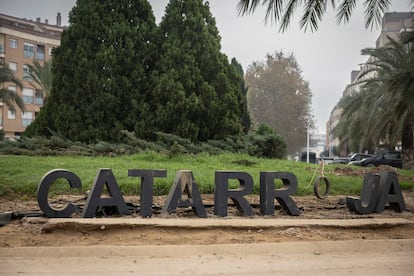
Every morning, Juanjo Moreno, whose wife Pili is a hairdresser who has lost everything, wakes up wondering if this will be the day when someone finally shows up on their street to carry out a thorough cleaning. “But no one comes,” he laments. “Every day we wake up with hope, and every day we go to bed with the same disappointment, without anyone informing us of anything. The firefighters, or the UME (Emergency Military Unit), or the Army have been here sometimes. But they have come for specific things. And we alone cannot go any further. We need the street to be returned to a minimally habitable and healthy state.”
Juanjo is waiting for someone to arrive, much as the residents of Villar del Río anxiously waited for the Americans who never showed up in the classic 1953 satirical comedy Welcome Mr. Marshall!. Except in this case, the mayor has not come around to provide any explanations. On Sunday a truck from Emacsa, the municipal water company from the Andalusian city of Córdoba (around 500 km or 310 miles away) shows up on the street. The workers find the sewers completely backed up. There are all kinds of things inside, even a car baby seat.
In addition to cleaning the sewers, the workers from Córdoba also send in an alert over the street’s terrible conditions. And on Monday, finally, a small army of cleaners arrives: they are personnel from Plan Infoca, the Andalusian regional government’s agency for fighting forest fires. There are more than 100 people dressed in yellow and they have been tasked with removing the immense layer of mud that still covers everything and needs to be lifted with machinery. The prayers of Juanjo and the rest of the street’s residents have been answered, 27 days later. They are received like heroes. A neighbor makes a video of them for TikTok.
Three days later, the street looks very different. For the first time in a month, it doesn’t look like a war zone. The pedestrian crossings are back. The sidewalks are no longer a shapeless mass of mud. There’s even a new manhole that the emergency services hadn’t noticed under the mud.
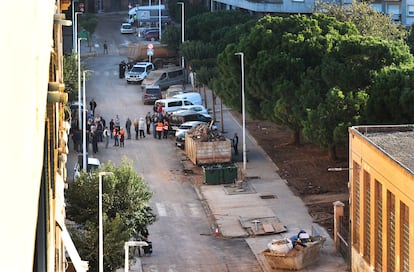
“Are they really saying things are going back to normal? Do you see anything normal here?”
The street is certainly looking much better without the mud and the sewage, which gives the residents a “psychological boost.” But there are still many problems to deal with. There is not a single business open. In the block of low-rise houses there are several that have been evacuated and sealed off due to the risk of collapse. And yesterday they told those who live in the other ones that they have to leave too, something that the owners are trying to avoid unless they are shown an official report. At the school at the end of the street, Colegio Larrodé, there is some good news: it is opening its doors again today. But secondary students will have to learn online until they get prefabricated classrooms, because many parts of the school still cannot be used. Meanwhile the public secondary school I.E.S. Berenguer Dalmau, attended by 1,500 students, is still a wreck, closed and sealed off. It is unclear what will become of it. The teachers have organized online classes while other solutions are found, which will probably involve temporary barracks.
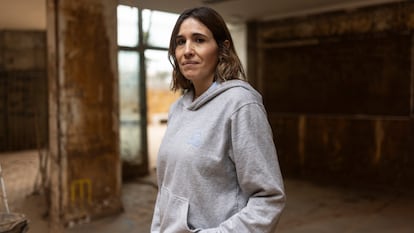
There are still wrecked cars on the street, covered in mud and dust, because their owners are hoping that the “insurance people” will come around, which they haven’t yet; the vehicles bear written signs warning that they are not to be removed. The food and basic goods delivery point on the avenue is still open, but nobody knows for how much longer as people have to go back to work. On the perpendicular road there is a large open section of sidewalk covered in mud and rubbish, which Rubén and Eva look at fearfully along with little Zoe, their five-year-old daughter.
The mood of the locals is far from normal. Amparo Díaz and Antonio Luna have not yet left their apartment because they cannot go up or down stairs and the elevators are not working, nor does anyone know when they’ll be operational again. Nuria Cabezas, who lost her house, says she is not feeling “well at all.” María Asencio, who lost the clothing boutique she runs with her daughter, Sarai, is exhausted. Pili Pérez, who lost her hair salon, says she is living “in Groundhog Day”: “We put on our clothes, our boots, we go to clean and fix things, we get into bed. And so it has been every day for a month.” They all start crying at the slightest provocation, as soon as they start telling their stories.
“I’m not even angry anymore,” says Cristina Sigalat, one of the women who runs the food and basic goods collection and delivery point. “I’m just sad and disappointed. Are they really saying that things are going back to normal? Do you see anything normal here?” She is particularly worried about the garage in her apartment building. The garage at number 36 was emptied out by the residents with the help of volunteers’ machines and after paying a sum to a company. The garage at number 7 was emptied by the fire brigade because people had died inside. But the garage at number 32, Cristina’s building, is still full of liquid, stagnant mud, cars, and belongings that have been sitting there in extremely unsanitary conditions for weeks.
The handling of this issue has been erratic. In the first few days, emergency services helped residents to remove mud from garages with machinery. Then, authorities told homeowner associations that they would have to take care of it and pay for it themselves. More recently they were informed that they had to sign up to a list and that the Valencia Provincial Authority would take charge. This week, Spain’s Minister of the Interior, Fernando Grande-Marlaska, contacted Valencia regional premier Mazón and the head of the Valencia Provincial Authority, Vicente Mompó, to express his concern about the delay in addressing this matter, which, if prolonged over time, can affect both public health and the structures of buildings.
Finally, on Thursday, homeowners at Number 32 were informed that a company hired by the provincial authorities is going to start emptying their garage and storage rooms. “It seems that ours is going to be the first in Catarroja,” says Cristina. “Thank goodness they are coming now.”
Catarroja: 170 garages flooded and more than 30% of public lighting not working
Beyond Blasco Ibáñez Avenue, the situation in the rest of Catarroja, where 30 people died due to the flooding, is not good either. The local councillor for Urban Development, Martí Raga, of the leftist regional political party Compromís (the mayor, Lorena Silvent, belongs to the Socialist Party) provides an account of the damage:
There are still 170 flooded garages in town. There are 2,500 primary school students and 3,000 secondary school students who have not returned to the classroom. The music conservatory and sports facilities are destroyed. At least 30% of the street lighting does not work. When it gets dark, there is no light in much of the town and walking through its streets is scary. In this darkness, what you see best is the suspended dust that is everywhere.
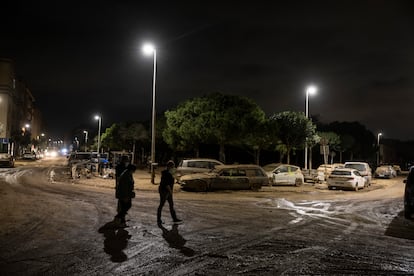
The local courthouse has not opened, nor does it look like it will do so for at least the next six months. Businesses are mostly closed after sustaining extensive damage: 700 in the town itself and 500 in the nearby industrial park. Nobody has a car anymore and public transportation is stretched to the limit. Very close to Blasco Ibáñez Avenue there is a car cemetery with thousands of them piled on top of each other — there are a total of 120,000 cars destroyed by the floods accumulated in 60 locations. Minister Grande-Marlaska has also asked this week for the vehicles to be taken as soon as possible to treatment centers so they can be converted into scrap metal.

Suddenly, there are glimpses of something resembling normality. There are two main streets in town. On one, Camí Real, the one where Town Hall is located, some businesses (very few) have reopened, and you can see people again at the bank, or having a coffee at David Kebab, or getting a haircut at Barbería Brooklyn, or going into the supermarket Mercadona, which reopened on November 22 and is like an oasis of cleanliness in the middle of the disaster: everything is spotless and smells of fabric softener and bread. The health center started operating that same day. But on the other main avenue in town, La Rambleta, the feeling that something is improving, even if just a little, suddenly disappears. Walking down it means walking through a succession of wreckage, stinking basements, broken glass, closed and destroyed stores, mud, and dust.
“The emergency has stagnated in Catarroja, like the mud,” says Councillor Raga. “It will be very difficult to return to the pre-storm era. The municipality needs many more personal and material resources and more help. Us and everyone else. This cannot be prolonged over time. There are 200,000 of us affected, 33% of Valencia’s GDP. All of us have a very strong psychological hangover.”
After the trauma: “When the adrenaline went down, I went down too”
Let’s go back to Blasco Ibáñez Avenue. What the psychologists said would happen is already happening. At first the residents found superhuman strength to get ahead, clean, tidy up, help others... but many are already exhausted, disillusioned, without hope.
“I am not feeling well at all,” says Nuria Cabezas, 35. She immediately starts crying. “I feel mentally exhausted. I can’t get the words out, I have mental blocks. Since October 29, I have not been myself. I go to the child’s training, for example, and I am not really there. My head is always back here, thinking about that night, about the fact that we have no home, no memories, and we don’t know when we will be able to return.” Inside their home there are some brand new mattresses that someone gave them, but the place is still uninhabitable. They have to redo the closets, the bathrooms, buy absolutely all the furniture again, repaint, check the electrical network. “We have been living at my mother-in-law’s house for a month with my husband Emilio’s two children. My son has gone with his father. And we have no prospect of being able to return here in months. We still don’t know anything about the insurance or the direct aid, and without money we cannot move forward.”
Nuria is receiving therapy. “When the adrenaline went down, I also went down,” she explains. “Also, I have a fear that won’t go away. I see it raining and I start to shake. With the latest storm warning, I had an anxiety attack. I think all the time that another flood could come. What we saw and experienced that night was horror. It will stay with us forever.”
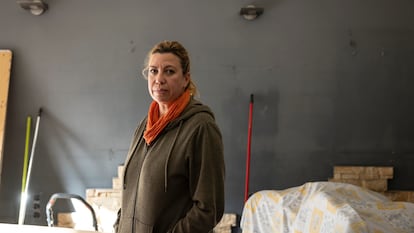
“We have ups and downs,” says Pili Pérez, the 51-year-old hairdresser. “And now it is all about waiting and waiting. Waiting to see if they come to fix the street once and for all, if the insurance experts show up, if more aid arrives. The only one we have received so far is from Juan Roig [owner of the Mercadona supermarket chain] for the self-employed. In a few days they paid us €8,000. I hope that the aid the government has announced will be quick and agile, because without money this whole hell is going to go on forever.”
Maria Asencio, in the shop next door, Lola Guarch, says she is exhausted. The fatigue is evident on everyone’s face a month after the flood. “Now we have also seen cracks in the walls that were not there before. I don’t know if it is because the garage below is still flooded. Please, don’t forget about us. There is still a lot of crap here. We need help, because psychologically this is affecting us a lot.” Maria also lives in one of the low-rise houses that authorities have just decided need to be evacuated. “But they haven’t told us much, beyond the fact that a firefighter has considered that the whole block is at risk,” says her daughter Sarai, 29. “We are going to ask an architect to come take a look.”
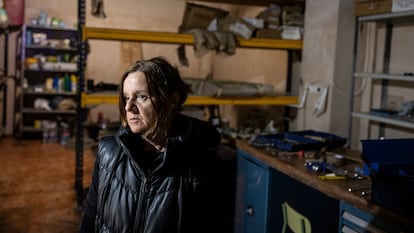
The new victims: “I haven’t left home for a month”
As time has passed, new victims of the flood have appeared. They are people whose homes were not destroyed because they live on the second, third, fourth, or fifth floors of apartment buildings, but who have not been able to leave since October 29 because they are elderly or have mobility problems and the elevators do not work. There are two of them at number 32 on Blasco Ibáñez Avenue: Antonio Luna and Amparo Díaz.
Amparo is 84 years old and lives with her daughter Fany, 57, and her granddaughter Aitana, 23. Fany recently underwent surgery for ovarian cancer and she hardly ever goes out. She gets very tired and is scared of living with so much filth and mud, so she has been looking after her mother 24 hours a day for a month. Aitana is the one who brings them medicines, food, everything they need. They live on the second floor. Amparo goes from the bed to the kitchen, from the kitchen to the bathroom, from the bathroom to the bed. She is not very aware of what has happened outside, they have only told her that there was flooding and that she cannot go out. She cries non-stop, she looks at you intently and says that she just wants to die and stop being a burden on her family.

Before, she would go out every day in her wheelchair. Hortensia, her caregiver, would take her to the market or to drink an horchata and then she would spend the afternoons with Fany. But now there is nothing. “Since that night, she dreams a lot and calls out for her mother,” her daughter says. “That night” is what many call October 29, which has marked a before and after in their lives.
Antonio and Tere live one floor above. Antonio, 72, is not breathing well. He has chronic obstructive pulmonary disease, wears an oxygen mask for many hours a day and cannot go down stairs, much less climb them. He has spent a month between the dining room chair and the balcony. He goes out there to get some fresh air and have shouted conversations with his neighbors. They send him food on a rope. But he confesses, in tears, that he is desperate. “I used to go to the market or have a coffee every day,” he says. “Now I am locked indoors, and with an anxiety that I can’t get rid of. Thank goodness my children and grandchildren come to see us because in here you get overwhelmed. I am sad, without hope for anything, depressed. Not even soccer entertains me. I sleep very little and I am looking forward to the dawn to stop thinking about everything. But then I have nothing to do either. And it could be months before they fix the elevators.” He cries again.
What remains to be done: “We need many more resources”
“There is still a need for a lot of machinery here, more institutional presence,” says a volunteer at a food distribution point. “It’s been a month now. Sometimes we get the feeling that they are not aware of the conditions we are living in. If they knew, this place should be full of people helping citizens to get back to normal, and that is not happening. You go through the town and yes, you see some streets with firefighters, some with soldiers… but most of them are empty. You don’t get the feeling that there is any intensive reconstruction work going on. And anyone who walks around here for a day can see this, there is no need for a big investigation. Does the mayor not know it? Does the regional government not know it? Is the emergency situation really going to last forever in Spain in 2024 due to a lack of resources?”
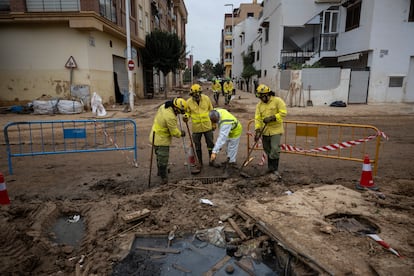
Everything takes a long time. Mireia García, the head of studies at the Paluzié public school, regrets that no one has yet come to see to the few things that need fixing so that they can reopen. “There has been no structural damage at this school,” she says. “What we need is only some minor work. But they have to come do it, and they haven’t come. Don’t they realize how important it is for children to go back to school? We have 206 students here. At most 10% of them are relocated in other centers. The rest have been at home for a month.” Families fear that the recent death of a worker at a school in Massanassa has left the authorities in shock and everything will be slowed down even further.
Back on Blasco Ibáñez Avenue, Cristina, who is in charge of managing the food and basic products point, reflects on the reconstruction work. “What the politicians have not yet understood is that when we complain, when we say that we have felt abandoned, what we are asking for is more institutional action,” she says. She defines herself as a left-wing voter, and is very critical of the management of the crisis by regional premier Mazón and his government as a whole. “But I think that everyone should review their actions in this disaster,” she argues (regional authorities have blamed the slow response on the national government, headed by a socialist-led coalition). “At the municipal level, I do not understand why a month later the councillors of the six zones into which the municipality is divided are not on the street all day long talking to the residents and jotting down their needs and ordering the priorities. Nobody has come to us to ask us anything. You call them and they don’t pick up. You go to the Town Hall and they ask you to fill out forms. These towns are not so big. Where is the mayor? We haven’t seen her.”
She also regrets that political polarization is preventing cooperation in the face of a tragedy of this magnitude. “They cannot ask us to avoid mentioning that we’ve pulled through thanks to volunteers so as not to give wings to the far right. I am very concerned about the rise of populism, but that does not mean that I cannot criticize this crisis management. I have been down on the street for a month. If Mazón was not capable of leading this, which he has not been, the [central] government should have taken charge. And even if they believed that it was better for the coordination to be handled at the regional level due to being physically closer, which it may be, they should still have tried by all means to get more involved, to exert more pressure. In any case, I would tell everyone that there will be time enough to determine everyone’s responsibilities. Now they should focus on what we urgently need: many more resources, more information, and for the aid to be easily and quickly accessible.”
When people meet on the streets of Catarroja there is only one topic of conversation. They talk about “that night,” about where their son or daughter-in-law are living right now, whether or not it is true that Paco has died, how they are going to get ahead, how they have to look after their grandchildren because there are no schools, how the buses are packed early in the morning and take hours to get where you need to be, or how it seems impossible that things will ever get back to normal. “You get up, you put on your clothes, and you go into the mud,” says an older man to a friend he has run into. “But the mud never ends, never ends, never ends.”
Although almost everything is closed, there are two lottery offices open, and there are huge lines outside. Many people ask to buy numbers ending in 29 or 9. “I wake up crying and I go to bed crying,” says Amparo, 79, who has already survived three floods. In the first one, in 1957, what she saw floating on the rising waters were horses and cows. This time, it was tens of thousands of cars, trees, streetlights, people. “If we were to win at least a little bit of the lottery, we could fix our houses and our businesses,” she says. “Maybe after the misfortune, some luck will come our way.”
Sign up for our weekly newsletter to get more English-language news coverage from EL PAÍS USA Edition


